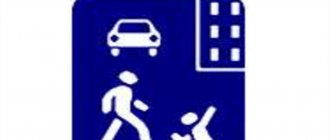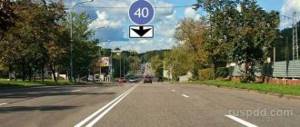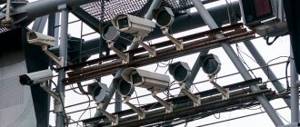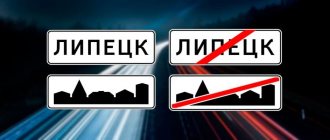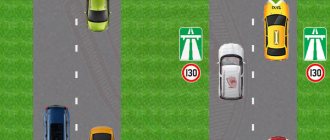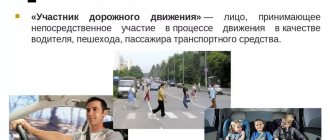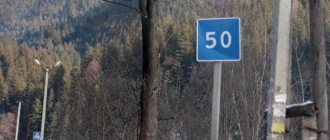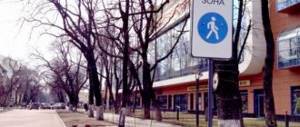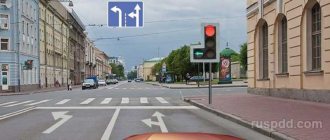In 2021, the Russian government introduced changes to the Administrative Code, and some of them have already come into force. The innovations also affected motorists. In this article we will tell you how the fine for speeding has changed in 2021, what speed is considered acceptable, as well as how to pay and how to appeal the received fine.
An advantageous offer from the partners of our portal - Terem Loan! Apply for a loan in the amount of up to 30 thousand rubles for a period of up to 30 days.
100% approval!
Get money
Speed table on Russian roads
| Vehicle | Locality | Outside the populated area | Motorway | Living sector |
| Cars | 60 | 90 | 110 | 20 |
| Passenger cars with trailer | 60 | 70 | 90 | 20 |
| Category B trucks | 60 | 90 | 110 | 20 |
| Category C trucks | 60 | 70 | 90 | 20 |
| Trucks with people in the back | 60 | 60 | 60 | 20 |
| Motorcycles | 60 | 90 | 110 | 20 |
| Intercity buses | 60 | 90 | 90 | 20 |
| Small buses | 60 | 90 | 90 | 20 |
| Other buses | 60 | 70 | 90 | 20 |
| Buses for organized transportation of children | 60 | 60 | 60 | 20 |
| When towing mechanical vehicles | 50 | 50 | 50 | 20 |
Tweet
The table is compiled on the basis of paragraphs 10.2 - 10.4 of the traffic rules.
Motorway speed limit
A motorway is a road that has the highest permitted maximum speed:
110 km/h : for cars, category B trucks, motorcycles.
90 km/h : for cars with trailers, category C trucks, buses.
60 km/h : for trucks with people in the back and buses with organized transportation of a group of children.
50 km/h : when towing a motor vehicle.
In 2021, the number of highways in Russia remains small, so not all drivers have had time to get acquainted with this type of road. Motorways are generally in excellent condition and are safe to drive at high speeds.
Maximum speed outside the city
The speed limit outside built-up areas applies to all roads that are not motorways:
90 km/h : for cars, category B trucks, motorcycles, intercity and small buses.
70 km/h : for cars with trailers, category C trucks, other buses.
60 km/h : for trucks with people in the back and buses with organized transportation of a group of children.
50 km/h : when towing a motor vehicle.
Unlike highways, other country roads may be in different conditions. Therefore, you should not drive on unknown roads at the maximum speed limit, because... Unexpected obstacles or poor road conditions can lead to an accident.
In what case do you have the right to drive in a populated area at a speed of more than 60 km/h?
| 1. | Only when overtaking. |
| 2. | Only if there are road signs allowing driving at speeds over 60 km/h. |
| 3. | In both of the above cases. |
The rules prohibit driving in populated areas at a speed of more than 60 km/h, including when overtaking, with the exception of those places where “Maximum Speed Limit” signs are installed, allowing higher speed limits.
Permitted speed in the city
Speed limits apply to all roads inside populated areas:
60 km/h : for all vehicles.
50 km/h : when towing a motor vehicle.
20 km/h : when driving in a residential area, bicycle area or courtyard area.
In populated areas, the speed limit is low, because... they simultaneously contain a large number of vehicles, pedestrians, and various intersections. In addition, visibility in cities is limited by buildings and structures. When driving at a speed of 60 km/h, the driver has time to control the situation and, if necessary, can avoid a collision.
Some drivers believe that the maximum speed in the city is 80 km/h, not 60. The argument is that the fine is imposed only after 80 km/h. This approach is fundamentally wrong, because if an accident occurs in which one of the cars is driving at a speed of 61 km/h, it is this car that will be recognized as the culprit (or one of the culprits, if the second driver is at fault) and it is its driver who will be pay for repairs to someone else's vehicle.
The goal of any responsible driver is not to evade fines, but to prevent possible road accidents. In this regard, I recommend observing the speed limit absolutely always, avoiding even minimal excesses.
Speed and distance in figures and facts
Never rush. A skilled driver is, first of all, one who knows how to choose the speed in accordance with the road conditions. "Fast when possible, slow when necessary."
Now let's approach this topic practically. Regulations and restrictions on the speed limit in the traffic rules of the Republic of Kazakhstan are given not only in section Chapter 10 “Speed”, but are also given in other chapters that determine special traffic conditions, for example, passage through railway tracks, towing, transportation of people and goods, etc. .d. We will try to collect all this scattered information together - this will be a help for drivers and a training manual for those who are just preparing to become a driver. Let's start with the minimum number and then ascend.
And so: 8 km/h - if the speed of the vehicle according to the technical specifications is less than 8 km/h when passing through a railway crossing, it is permitted only with the agreement and permission of the head of the railway track.
20 km/h is the maximum speed for vehicles in residential areas.
30 km/h – In the area of sign 3.22 “Overtaking is prohibited”, overtaking of all vehicles is prohibited, except for single vehicles moving at a speed of less than 30 km/h.
– 3.21 overtaking is prohibited for trucks with a gross weight of more than 3.5 tons, except for single vehicles moving at a speed of less than 30 km/h.
40 km/h – On highways marked with sign 5.1, the movement of vehicles whose speed, according to their technical characteristics or their condition, is less than 40 km/h is prohibited. 9.5. Vehicles whose speed should not exceed 40 km/h for technical reasons cannot reach such a speed must move in the far right lane, except for cases of detour, overtaking, changing lanes, as well as for turning left, making a U-turn.
9.11. On roads outside the city, drivers of all vehicles whose speed should not exceed 40 km/h are required to maintain such a distance between their vehicle and the vehicle moving ahead so that vehicles overtaking them can easily change lanes to the previously occupied lane.
This rule does not apply during heavy traffic in an organized column.
50 km/h – The maximum permissible speed when towing motor vehicles.
60 km/h a) Maximum speed for all vehicles in built-up areas (indicated by sign 5.22 on a white background). b) The maximum permissible speed when transporting passengers in the back of a truck.
70 km/h – Maximum permissible speed outside the city
– trucks with a permissible maximum weight of more than 3.5 tons.
– passenger cars with trailers
– city and tourist buses, including those transporting groups of children.
90 km/h – Maximum speed – outside the city – cars with a permitted maximum speed of up to 3.5 tons, intercity buses, especially small buses. On highways - trucks with a gross weight of more than 3.5 tons, cars with trailers, city buses, tourist buses, including those transporting groups of children.
110 km/h – maximum permitted speed – on highways – for trucks with a maximum weight of no more than 3.5 tons. Intercity and minibuses.
In non-populated areas - cars and motorcycles.
140 km/h is the maximum permitted speed for cars and motorcycles on highways.
10.5 The driver is prohibited from:
– Exceed the maximum speed determined by the technical characteristics of the vehicle;
– Exceed the speed indicated on the “Speed Limit” identification sign installed on the vehicle.
– Obstruct other vehicles by driving unnecessarily at too low a speed.
– sharply unless necessary to prevent a traffic accident.
If the maximum speed exceeds the established technical specification, the vehicle may lose the necessary stability and controllability on the road. Parts of the engine and chassis may fail, or they may not be able to withstand the load of the tire.
By prohibiting movement unnecessarily at too low a speed, thereby interfering with other vehicles, the Rules mean that the vehicle is in good working order and there are no other factors preventing movement at the permitted speed.
Emergency braking in conditions may be unexpected for other drivers, so the Rules allow you to drive through a controlled intersection without resorting to emergency braking. At the same time, this requirement of the Rules does not prohibit drivers from using emergency braking in cases where it is necessary to prevent a traffic accident. The DRIVER must choose a distance such that in the event of sudden braking of the vehicle in front, a collision can be avoided. In the city it should be ½ the speed of movement, and outside the city - 1/1. Or speed 100 km/h distance 100 meters. Drivers, speed is a great advantage of a car; use this benefit correctly so that it does not turn into a detriment. Stay healthy and safe.
18 total today
Also interesting for you!
Driving through intersections with new traffic lights
HISTORY of the Rules of the Road, from birth to the present day, with the latest changes and additional...
VIOLATION AND PUNISHMENT
Traffic jams - realities of the day
If only it were in the traffic rules. Or Traffic rules do not tolerate the subjunctive mood. Example…
CYCLIST on a PEDESTRIAN CROSSING
← Previous post
Next entry →
Leave a comment Cancel reply
Speed limit sign
The general speed limits in force on Russian roads in 2021 were discussed above. However, in addition to them, the maximum speed can be further limited using a special road sign 3.24 “Maximum speed limit”. If there is such a sign, the driver must drive at a speed not exceeding the value on the sign.
Consider a 90 km/h sign posted in a city. Despite the fact that the number on the sign exceeds the maximum speed in populated areas (60 km/h), such a sign is not an error. This sign allows driving at a maximum speed of up to 90 km/h, even in the city. It is installed on safe roads by decision of the executive authorities of the constituent entities of the Russian Federation (clause 10.2 of the traffic rules).
Consider a sign with a speed limit of 140 km/h. What should you do if you see such a sign? The essence of the problem is that the indicated sign does not make sense. The maximum speed on roads in the Russian Federation is 130 km/h (clause 10.3 of the traffic rules). This speed cannot be exceeded under any circumstances. So after such a sign in the city you need to drive not 140, not 130, but 60 km/h , because the sign is fake.
This road sign:
| 1. | Recommends driving at a speed of 40 km/h. |
| 2. | Requires moving at a speed of at least 40 km/h. |
| 3. | Prohibits driving at speeds exceeding 40 km/h. |
A round shape and a red border are signs that the sign belongs to the prohibitory group. The “Maximum speed limit” sign prohibits driving at a speed exceeding that indicated on the sign, in this case more than 40 km/h.
Traffic police fines for speeding in 2021
Fines for speeding directly depend on how much the driver exceeded the speed limit.
Punishments for recording a violation by a traffic police officer
| Over speed | Penalty for first offense | Punishment for repeat violation |
| 0 - 20 km/h | not punished | not punished |
| 20 – 40 km/h | 500 rubles | 500 rubles |
| 40 – 60 km/h | 1,000 - 1,500 rubles | 2,000 - 2,500 rubles |
| 60 – 80 km/h | 2,000 - 2,500 rubles or deprivation of driver's license for 4-6 months | deprivation of rights for 1 year |
| 80 km/h or more | 5,000 rubles or deprivation of driver’s license for 6 months | deprivation of rights for 1 year |
Accordingly, the greater the speeding, the more severe the possible punishment.
Note. Repeated speeding is committed within 1 year from the date of payment of the fine or the end of the imprisonment period for a previous similar violation.
In practice, speeding can be recorded both manually by traffic police officers and with the help of automatic video cameras for speeding.
Fines for speeding cameras
In 2021, it is the cameras that record the largest number of excesses, so I propose to consider the features of imposing fines using automatic means.
In this case, 3 basic rules apply:
- For a violation recorded by a camera, the driver cannot be deprived of his license or receive a warning.
- The maximum fine is imposed on the driver if the relevant article provides for deprivation of rights.
- The minimum fine is imposed on the driver if the relevant article does not provide for deprivation of rights.
Amounts of fines for speeding recorded using automatic video recording equipment:
| Over speed | Penalty for first offense | Punishment for repeat violation |
| 0 - 20 km/h | not punished | not punished |
| 20 – 40 km/h | 500 rubles | 500 rubles |
| 40 – 60 km/h | 1,000 rubles | 2,000 rubles |
| 60 – 80 km/h | 2,500 rubles | 5,000 rubles |
| 80 km/h or more | 5,000 rubles | 5,000 rubles |
